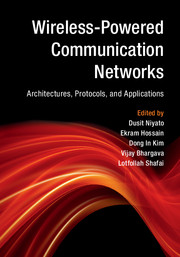Book contents
- Frontmatter
- Contents
- List of contributors
- Preface
- Part I Basics of Wireless Energy Harvesting and Transfer Technology
- Part II Architectures, Protocols, and Performance Analysis
- Part III Applications of Wireless Energy Harvesting and Transfer
- 9 Sensor Networks with Wireless Energy Harvesting
- 10 Cognitive Radio Networks with Wireless Energy Harvesting
- 11 Mobile Ad-Hoc Networks and Delay-Tolerant Networks With Wireless Energy Harvesting
- Index
- References
10 - Cognitive Radio Networks with Wireless Energy Harvesting
from Part III - Applications of Wireless Energy Harvesting and Transfer
Published online by Cambridge University Press: 01 December 2016
- Frontmatter
- Contents
- List of contributors
- Preface
- Part I Basics of Wireless Energy Harvesting and Transfer Technology
- Part II Architectures, Protocols, and Performance Analysis
- Part III Applications of Wireless Energy Harvesting and Transfer
- 9 Sensor Networks with Wireless Energy Harvesting
- 10 Cognitive Radio Networks with Wireless Energy Harvesting
- 11 Mobile Ad-Hoc Networks and Delay-Tolerant Networks With Wireless Energy Harvesting
- Index
- References
Summary
Introduction
A cognitive radio network (CRN) is an intelligent radio network in which unlicensed users (i.e., secondary users) can opportunistically access idle channels when such channels are not occupied by licensed channels (i.e., primary users). The main purpose of CRNs is to utilize available spectrum efficiently, since spectrum is becoming more and more scarce due to the boom in wireless communication systems. Basically, we can define a cognitive radio as a radio that can change its transmitter parameters as a result of interaction with the environment in which it operates [1]. From this definition, there are two main characteristics of cognitive radio that are different from traditional communication systems, namely cognitive capability and reconifigurability [2].
• Cognitive capability. This characteristic enables cognitive users to obtain necessary information from their environment.
• Reconfigurability. After gathering information from the environment, the cognitive users can dynamically adjust their operating mode to environment variations in order to achieve optimal performance.
To support these characteristics of cognitive radio, there are four main functions that need to be implemented for cognitive users.
• Spectrum sensing. The goal of spectrum sensing is to determine the channel status and the activity of the licensed users by periodically sensing the target frequency band.
• Spectrum analysis. The information obtained from spectrum sensing is used to schedule and plan for spectrum access.
• Spectrum access. After a decision has been made on the basis of spectrum analysis, unlicensed users will be allocated access to the spectrum holes.
• Spectrum mobility. Spectrum mobility is a function related to the change of operating frequency band of cognitive users. The spectrum change must ensure that data transmission by cognitive users can continue in the new spectrum band.
Under these functions, cognitive users can utilize the limited spectrum resource in a more efficient and flexible way.
Recently, the development of wireless power transfer technologies has brought a new research direction, called wireless-powered cognitive radio networks (CRNs), which would seem to provide a promising solution for energy conservation for CRNs. In wireless-powered CRNs, secondary users are able to harvest energy wirelessly and then use the harvested energy to transmit data to the primary channels opportunistically.
- Type
- Chapter
- Information
- Wireless-Powered Communication NetworksArchitectures, Protocols, and Applications, pp. 338 - 382Publisher: Cambridge University PressPrint publication year: 2016



